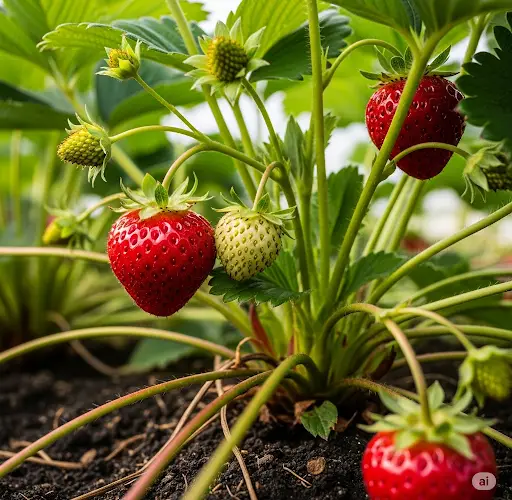Strawberries are among the most popular and rewarding fruits to grow in home gardens. Their sweet, juicy berries are a favorite treat and a symbol of summer’s arrival. However, many gardeners struggle to achieve high yields, often getting only a modest crop from their strawberry plants. What if there was a simple method you could apply in May, during the spring season, that would increase your strawberry harvest tenfold?
This article reveals an effective, easy-to-follow technique that helps your strawberry plants grow stronger, produce more flowers, and set more fruit, resulting in a dramatically increased yield. Whether you grow strawberries in garden beds, raised containers, or pots, this springtime treatment will boost your crop and bring you plenty of delicious berries.
Why Does Strawberry Yield Sometimes Fall Short?
Before diving into the solution, it’s important to understand why strawberries sometimes fail to produce a large harvest:
-
Nutrient Deficiency: Strawberries are heavy feeders and require balanced nutrition, especially potassium and phosphorus, to form flowers and fruit.
-
Poor Soil Conditions: Strawberries prefer loose, well-drained, and fertile soil rich in organic matter. Compacted or nutrient-depleted soils reduce flowering and fruiting.
-
Improper Watering: Both drought and waterlogging can stress the plants, limiting fruit development.
-
Crowded Plants: Overcrowded strawberries compete for nutrients and light, resulting in smaller yields.
-
Lack of Maintenance: Failure to prune old leaves and runners reduces plant vigor and productivity.
Addressing these challenges is key to unlocking the full potential of your strawberry plants.
The Simple Spring Method to Boost Strawberry Yield by 10 Times
The secret lies in a targeted fertilizing and care routine applied in May, just as the plants begin their active growth phase. This treatment involves improving soil fertility, enhancing root health, and stimulating flower bud formation.
What You Will Need:
-
Well-rotted compost or humus
-
A balanced organic fertilizer high in phosphorus and potassium
-
Epsom salt (magnesium sulfate)
-
Mulch (straw or shredded leaves)
-
Water
Step-by-Step Instructions
-
Prepare the Soil:
Start by loosening the soil around your strawberry plants to improve aeration and root penetration. -
Add Compost:
Apply a generous layer of well-rotted compost or humus around the plants. Compost provides essential nutrients and enhances soil moisture retention. -
Apply Fertilizer:
Use an organic fertilizer rich in phosphorus and potassium to encourage flower and fruit development. Follow package instructions for the correct amount and sprinkle it evenly around the base of each plant. -
Supplement with Magnesium:
Dissolve about half a teaspoon of Epsom salt in a liter of water and pour it around each plant. Magnesium supports chlorophyll production and overall plant health. -
Water Thoroughly:
After applying fertilizers and supplements, water the plants deeply to help nutrients reach the roots. -
Mulch the Beds:
Apply mulch around the plants to conserve moisture, suppress weeds, and protect roots from temperature fluctuations. -
Remove Old Leaves and Runners:
Prune away old, yellowing leaves and unwanted runners to direct the plant’s energy into fruit production.
What Results to Expect
Within a few weeks of applying this method, you will notice remarkable changes:
-
Stronger Growth: Plants develop lush green foliage, signaling better health.
-
More Flowers: A significant increase in the number of flower buds forms, promising a larger fruit set.
-
Higher Fruit Yield: With improved nutrition and care, each plant produces many more strawberries than usual.
-
Better Fruit Quality: The berries are larger, juicier, and sweeter due to improved plant vigor.
Many gardeners report up to ten times the usual harvest when consistently applying this spring care routine.
Additional Tips for Maximum Strawberry Success
-
Plant Spacing: Ensure adequate space between plants (about 30–40 cm) to prevent overcrowding.
-
Consistent Watering: Maintain even soil moisture, especially during flowering and fruiting.
-
Pest Control: Monitor for common pests like slugs and aphids and manage them promptly.
-
Rotate Crops: Avoid planting strawberries in the same soil for more than 3 years to reduce disease risk.
Why This Method Works So Well
The combination of organic matter, balanced fertilization, magnesium supplementation, and pruning provides strawberries with everything they need to thrive. This balanced approach stimulates root health, encourages abundant flowering, and supports fruit development — all essential for maximizing yield.
Conclusion
If you want to transform your strawberry patch and enjoy a harvest ten times greater than before, applying this simple yet powerful care routine in May is the key. With proper soil preparation, fertilizing, watering, and pruning, your strawberry plants will thrive and reward you with bountiful, delicious fruit.
Try this method this spring, and get ready to enjoy some of the best strawberry harvests you’ve ever had!



